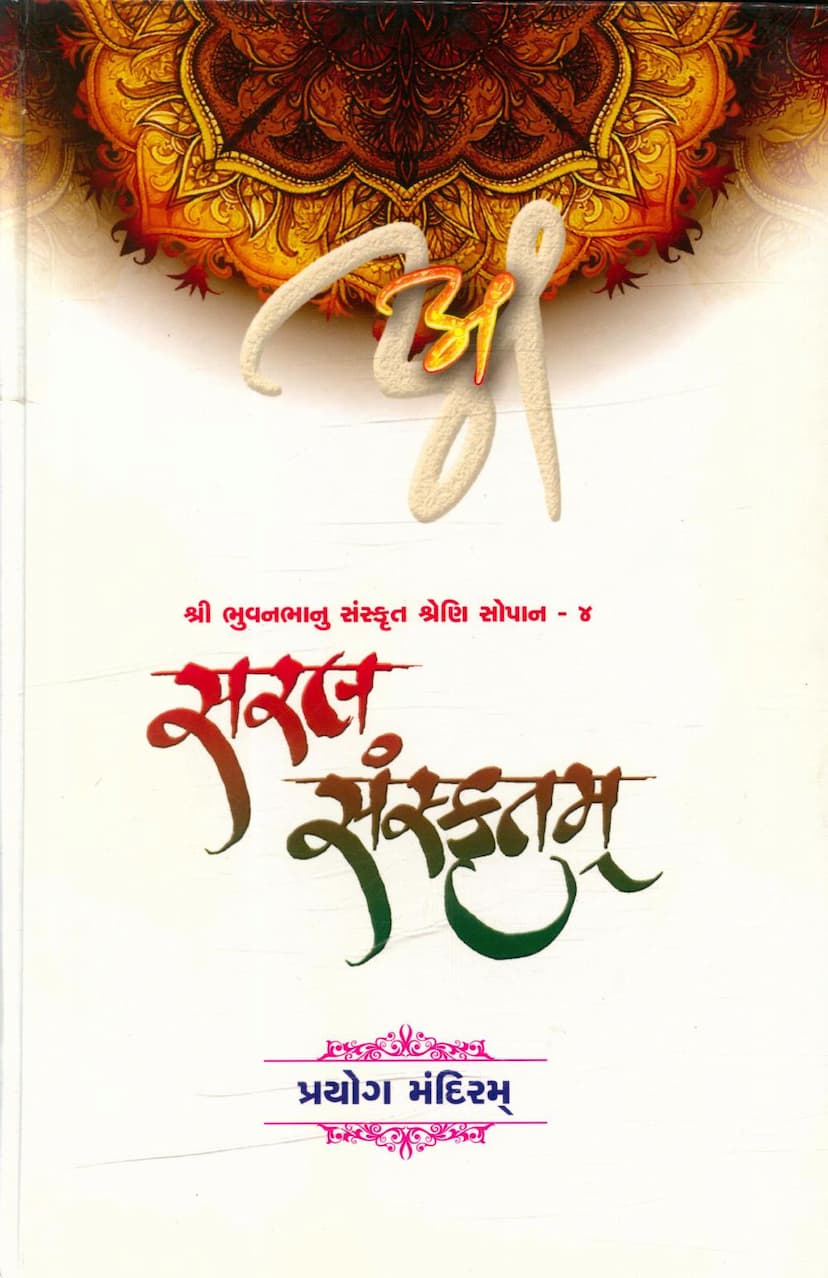Saral Sanskritam Part 04
Added to library: September 2, 2025

Summary
This is a comprehensive summary of the Jain Sanskrit text "Saral Sanskritam Part 04" by Yashovijay, published by Divya Darshan Trust. The summary is based on the provided page content.
Book Title: Saral Sanskritam Part 04 (સરલ સંસ્કૃતમ્ - પ્રયોગમંદિરમ્) Author: Yashovijay (પંન્યાસપ્રવર શ્રી યશોવિજયજી મહારાજ) Publisher: Divya Darshan Trust (શ્રી દિવ્યદર્શન ટ્રસ્ટ)
Overall Purpose and Theme:
"Saral Sanskritam Part 04" is presented as the fourth part of a series designed to make the study of Sanskrit accessible and practical. The title "Prayog Mandiram" (પ્રયોગ મંદિરમ્) translates to "Temple of Practice," emphasizing the book's focus on application and usage. The series aims to guide learners on a holistic journey through the Sanskrit language, ultimately connecting it to spiritual liberation (moksha) as envisioned in Jainism. The text highlights Sanskrit as the key to unlocking the profound teachings of Jainism, described as a treasure trove of invaluable principles and spiritual insights.
Key Features and Content:
- Connection to Jain Spirituality: The book is deeply rooted in Jain philosophy. It invokes prominent Jain Tirthankaras and Acharyas, including Lord Adinath, Lord Neminath, Lord Parshwanath, Lord Mahavir, and the esteemed Acharya Yashovijay. The ultimate goal is presented as achieving spiritual liberation by merging oneself with the divine essence, following the path laid out through Sanskrit grammar.
- Focus on Practice and Application: The book is designed as a "temple of practice" for Sanskrit. It acknowledges that while Sanskrit grammar might seem complex, this series offers new approaches to self-study, simplified explanations of rules, and easy methods for memorizing grammatical forms. It emphasizes that practical application ("practice") is as vital as knowing the rules, comparing it to learning to swim by practicing rather than just reading books.
- Comprehensive Structure: The book is organized into numerous lessons (Path) and examinations (Pariksha), covering a wide range of grammatical concepts and vocabulary. The table of contents (pages 10-12) details the progression of lessons, starting from basic grammar and moving towards more complex sentence structures and word usage.
- Didactic Approach: The text employs a teaching methodology that includes:
- Fill-in-the-blanks: To test grammatical knowledge and recall.
- Matching exercises: To connect Sanskrit terms with their meanings, verbs, persons, numbers, and suffixes.
- Translation: Both from Sanskrit to Gujarati and vice-versa, reinforcing understanding of sentence construction and vocabulary.
- Grammatical analysis: Identifying verbs, genders, cases, numbers, and the root verbs.
- Sentence construction: Building Sanskrit sentences from given Gujarati phrases or vice versa.
- Mind Games and Visual Aids: Later sections include elements like "Mind Games," "Picture Stories," and "Sentence Construction" to make learning engaging.
- Emphasis on Prakriya (Prakriya): The book highlights the importance of "prakriya" or practice. It states that without practice, one can drown in the ocean of Sanskrit, even with strict rules. The more practice, the more proficient one becomes in Sanskrit. The book offers various "recipes" or techniques for practice.
- Inclusion of Modern and Practical Elements: Beyond traditional grammar, the book incorporates sections on "Modern and Practically Useful Words," "List of Ambiguous Gender Words," and "Sanskrit Sentence Construction," indicating an effort to bridge classical Sanskrit with contemporary usage.
- Inspirational Tone: The book conveys a tone of deep devotion to learning and spiritual growth. It includes prayers, acknowledgments of divine grace, and expressions of gratitude to teachers and supporters. The introductory and concluding remarks often carry philosophical and motivational messages.
- Acknowledgments and Support: The book is dedicated to Jain spiritual leaders and acknowledges the support of the Vile Parle Shwetambar Murtipujak Jain Sangh and Charities, as well as individuals like Kumarpal V. Shah. This highlights a community effort behind the publication.
- Editions and Availability: The book mentions its first edition in V.S. 2067 and a revised second edition in V.S. 2070. It also lists several distribution points for obtaining the complete set.
Key Concepts Covered (Implied by Lesson Titles and Exercises):
While the detailed Sanskrit content isn't fully translatable without linguistic expertise, the structure and exercise types suggest coverage of:
- Verb Conjugation (Rup Siddhhi): Extensive practice in forming verb roots with various suffixes, persons, numbers, tenses, and moods.
- Noun Declension (Nam Siddhhi): Understanding and applying different cases, genders, and numbers to nouns and pronouns.
- Sandhi (Syllable Combination): Rules for joining words and the process of breaking them down.
- Samas (Compound Words): Identification and formation of various types of Sanskrit compounds.
- Sentence Structure: Analyzing and constructing sentences, including the role of different verb types (active, passive, causative, etc.) and the placement of indeclinable words (avyaya).
- Vocabulary Building: Learning Sanskrit words and their meanings, including those with multiple forms or genders.
In essence, "Saral Sanskritam Part 04" is a pedagogical tool that aims to make Sanskrit learning systematic, engaging, and spiritually rewarding within the Jain tradition. It bridges grammatical instruction with practical application and spiritual aspiration.